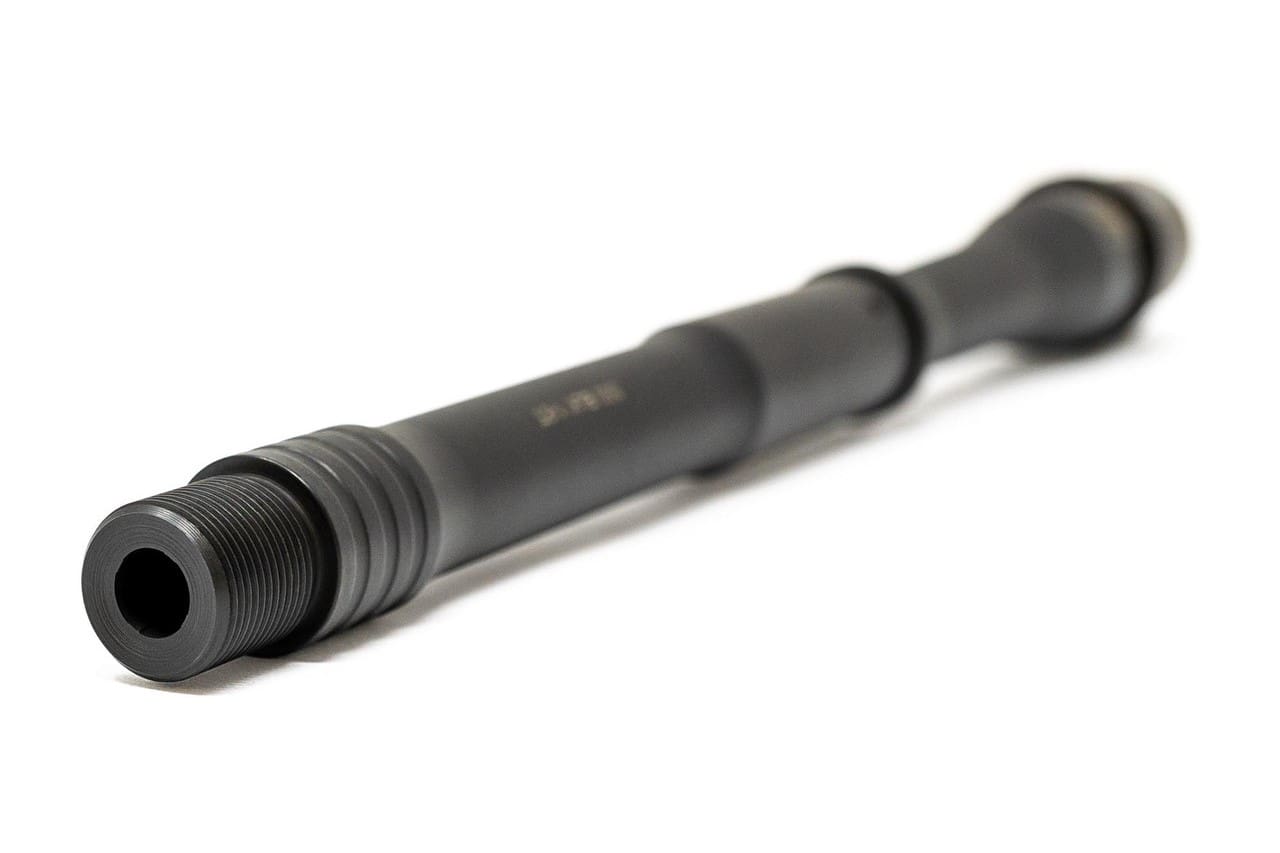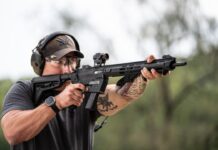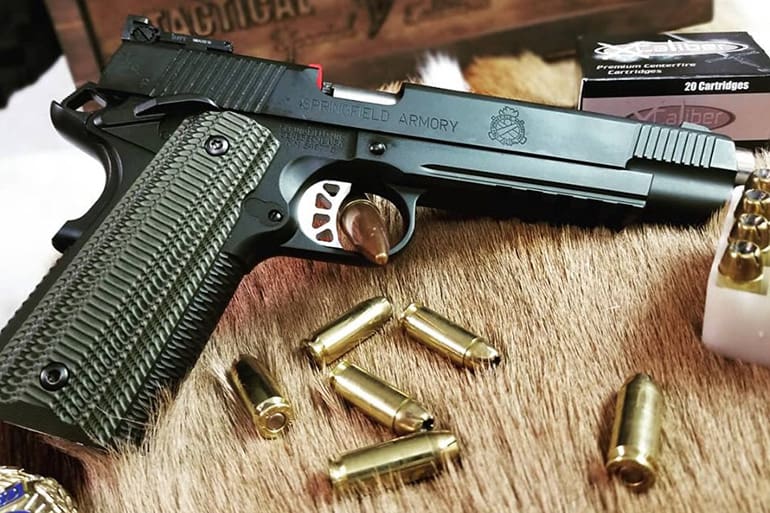Whether you’re hunting, defending your home, or just shooting suppressed at the range, 300 Blackout is a popular and adaptable cartridge. But barrel length can significantly impact your firearm’s performance. This guide takes a closer look at the various barrel lengths for the 300 Blackout round and where to find them.
The main question you need to ask yourself is whether or not you plan on using a suppressor. If you’re looking for the quietest and best handling setup, you could easily go as short as 7.5″, which is offered by makers like Faxon Firearms and others.
How Much Does Barrel Length Affect .300 BLK Velocity?
The 9″ 300 blackout barrel is the best overall barrel length with or without a suppressor, especially since an 8″ barrel is the minimum warranty barrel length for many suppressor manufacturers.
Best Barrel Length For Suppressed 300 Blackout
For optimal performance with a suppressed 300 Blackout, we recommend a barrel length of 8″-10″.

Attaching a 6″ suppressor to this barrel length results in a total length of 14″ to 16″, which provides optimal muzzle velocity for accurate long-range shots.
For longer range engagements with a suppressed 300 Blackout, use a 16″ barrel with a suppressor for an average velocity of over 2,630 fps, leading to more effective shots and minimal bullet drop.
Best 300 Blackout Barrel Length For Home Defense
The 300 Blackout round is an excellent choice for home defense as it combines power and efficiency with lethality when fired from a short-barreled rifle.
Using a short-barreled rifle is ideal for home defense as its compactness makes it easier to maneuver throughout the home. Despite its compact size, a .300 BLK round fired from a short barrel can still hit targets up to 100 yards away.

For optimal home defense with the 300 Blackout round, a barrel length of at least 6″ to 8″ is recommended.
Best 300 Blackout Barrel Length For Hunting
The ideal barrel length when hunting with .300 BLK is one able to reach long-range targets with sufficient bullet velocity and energy on target for a lethal impact.
Longer barrel lengths offer greater accuracy and velocity, with a maximum length of 16″ for the 300 BLK. This length ensures complete gunpowder combustion to generate maximum velocity and stabilizes the bullet for a flatter trajectory and improved accuracy.

Choosing The Right Barrel Length For The Can Be Hard
At 10″, the muzzle velocity hasn’t yet reached its peak. Heavy subsonic ammo in a 10-inch barrel may have lower velocities, but allows for the use of a suppressor without damaging your hearing. Supersonic ammo out of a 10-inch barrel retains rifle caliber velocities, but with more significant bullet drop at longer distances.
At 16 inches, muzzle velocities are near their maximum. As a result, heavy-grain subsonic bullets struggle to retain their subsonic terminal performance, while supersonic ammo has increased effective range and reduced bullet drop. The 16-inch barrel also provides greater energy on impact, regardless of ammo type.
Barrel twist rate also impacts performance and should be considered when selecting barrel length and determining the effective range of the 300 Blackout. For example, a 1:8 twist is best for lightweight supersonic rounds, while the 1:7 twist is recommended for heavy subsonic rounds with a suppressor.
There are a few factors to consider when selecting the ideal barrel length for a 300 BLK rifle and determining its effective range. But for a lot of shooters, it’s the ideal do-all round in an AR platform rifle.





So, who’s the “Staff Writer” for this?
According to Advanced Armament Corp – the entity that developed the .300 Blackout cartridge – it’s optimized for a 10″ barrel with suppressor. Yet this unnamed writer says that’s incorrect, and the optimum is at 16″. This may possibly be true, but I don’t see links to formally derived stats to back up this claim.
….the same content appeared at ‘breachbangclear.com’ about a week ago, they don’t attach a name to it either.
One of those AI chatbots that’s been in the news recently?
This isn’t that hard. The article is a little wordy but does a decent job of explaining that the best barrel length depends on what ‘optimal’ performance means to you.
If you are shooting supersonic loads, a 16” barrel gives you more velocity. This gives more energy on target, a flatter trajectory and less wind drift.
If you are shooting only subs, then even something as short as the Sig Rattler’s 5.5” barrel (less than 3.25” of rifling!) will be fine.
If you want a compact package with acceptable performance out of both supersonic and subsonic loads, then 8”-10” is a good compromise.
Mine has a 10″. Since suppressors are verboten in CA, I shoot 120g supersonic. I tried 220g subsonic, but the “boing” of the buffer spring was annoying enough to prompt me to upgrade to stainless and stick with the supersonics.
AAC didn’t develop a damned thing. They straight stole J.D. Jones design of .300 Whisper, gave it an ever so minor “redesign”, renamed it, and submitted it to SAAMI for certification.
Getting away with it because they had deeper pockets (costs a lot to get SAAMI cert) and Remington Defense backing.
https://en.wikipedia.org/wiki/.300_Whisper
I posted this but deleted it. 300 Blackout WAS stolen from 300 Whisper.
My friend bought a 300 Blackout upper from PSA and put a can on it.
He never got it to run right and put too much money into it.
This was years ago and PSA was no help at all.
Did you ever wonder why PSA always has 5 star reviews on their website
but horrible reviews on Trustpilot? They had a 1.5 star rating 3 years ago.
Now the ammo costs too much for a niche rifle caliber.
Buy a .308 from a legit company and save yourself headaches.
Especially since there are some lightweight 308 AR’s out there now. A 5.56 and a .308 will do everything you need it to do. Ammo can be found locally. Heck, my Walmart still sells .308 after the evil 5.56 and handgun ammo purge. They think it’s Fudd ammo.
In large part because of PSAK’s being very dangerous garbage until very recently. Chamber erosion, out of battery detonations in < 2k rounds, most of them. Piss poor cast trunnions where S7 forged are a necessity.
That coupled with your complaints is why.
Also, you shouldn't trust in Trustpilot. They are as dishonest as BBB/Angies List/etc. and ask bribes of companies to remove bad reviews. Don't believe in them, and never will.
@Dude
Yeah, but 9″ barrel in a folder housed in a backpack is absolutely useless in .308 or 5.56. Niche it may be, but it is exceptionally useful in that niche.
@Rob,
I have two .300 BLK uppers from PSA. One has operated perfectly right out of the box. The other had an issue with the gas block; I contacted PSA and they immediately fixed it at no charge and with no questions, and it also has run perfectly since then. I’ve had no problems with PSA’s Cust Service.
Not on my 300 blk. I have a Q Honey Badger Barrel Assembly which is 7″ and a Q Trash Panda. They term “best” is entirely subjective and influenced by intended purpose and individual needs. My purpose is close quarter confined space self defense, not hanging out a helicopter shooting wild boar, although that sounds like a helluva lot of fun.
I dismiss this entire article as slow news day page filler.
Assuming you’re serious about hand-loading, you can purchase internal ballistic software to sort this out from an educated standpoint rather than following rules-of-thumb. In any case, you need to start by fixing a variable (target velocity, barrel length, cartridge) and go from there. This type of software isn’t free, but as a one-time purchase it’s probably the best reloading tool you can get for the price and pays for itself quickly given the price of reloading components you’ll save.
Saying things like “…at 10″, the muzzle velocity hasn’t yet reached its peak…” is misleading when you’ve got a cartridge with a wide swing of bullet weights and charge weights. One thing is true – your bullet accelerates until it either runs out of fuel or leaves the barrel (technically, you’ll start losing velocity before all the powder burns as a portion of the energy is used to overcome the friction of the barrel itself).
Suppressor length is a grey area as it doesn’t count as barrel length or open-air (something in-between, depending on internal geometry), but through testing you can predict how a specific suppressor affects your velocity.
Having internal ballistic software to play with is an eye-opener in a lot of ways – for example I’ll never have a .308 longer than a 20 in. barrel as the majority of common loadings just don’t need anything longer. Yes, there are loads that can use longer barrels, but you need to have a specific goal in mind before there is a large benefit in this caliber.
In short, barrel length arguments or advice are pretty worthless in comparison to having actual mathematical data and testing. Pick the barrel length (or performance target) you want and build a load around it – then you can come up with some educated rules-of-thumb of your own.
agreed on this. As a simple example, shooting Titegroup and Blue Dot out of my SD9VE with a 4″ barrel gives almost no meaningful velocity change. It’s a few hundred FPS from my 16″ AR9. A lot of variables involved.
In the case of .308, if you’re doing a bolt gun the longer barrel lengths can make a huge difference if you have the right powders same as my 9mm example. The catch is on a semi auto you may wind up with weirdness around pressure curves. As an example my .243 Winchester LR308 based rifle is fine with IMR 7828 speed but Ramshot Magpro is just too violent with the rifle as configured. If I had an adjustable gas block maybe but in reality I probably need Rifle+2 gas. (That was a mistake I’ll rectify next barrel probably.)
JMO on this, 300BLK is VERY MUCH a reloader’s round. I want to get a barrel and file a form1 but just haven’t yet. I need to get the lathe going as well, and I haven’t had the time or patience to do it.
It’s an ad. All the pics are Faxon barrels. All the links go to Faxon’s website. The “article” is filled with generic statements we all knew in 2009, and some incorrect statements that conflict with the dozens of articles TTAG has posted in the past on 300BLK; look uo Leghorn’s articles on 300BLK for good data. And of the couple dozen barrels I’ve used in builds, only Faxons have given me fits with under-gassing (suspected out of spec gas port). BA, Rosco, WC, and others have all worked immediately without any specialty tuning.
Agree, it’s A very versatile round.
Great! Another shilling advertisement for Faxon Firearms products.
The deer I’ve taken with my 8″ 300 BO don’t know or care. 110gr Barnes VOR-TX. Since it’s suppressed, the other deer in the area don’t seem to mind either…..
Yeah, I lose some velocity for supers in an 8″. But double taps on steel from 100 yards with subs is…. laughably entertaining.
I feel strangely compelled to visit faxon.com and view their lineup of 300 blackout barrel lengths.
Have been shooting 300 for a few years now. Have an 8.2, 10.5 and a 16.0 inch. 8.2 is the shortest Rosco makes and it’s a really good barrel for me. Flash can under the handguard is sexy and with a 10-inch 300 Win mag rated can is 35.5 inches OAL Always thought of the 300 as a niche caliber, but I’m good with that. My handloads have taken a pig and a Racoon. I avoid max loads to increase case life, so speed isn’t as important as how accurate the load will shooot.
if you do want to talk, you can come to me. I am always available for you
Comments are closed.